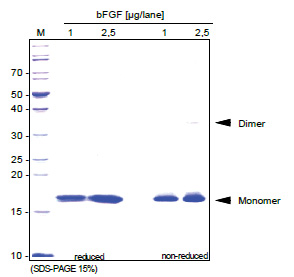FGF basic / FGF2 Human Protein
Other products for "FGF2"
Specifications
| Product Data | |
| Species | Human |
| Expression Host | E. coli |
| Expression cDNA Clone or AA Sequence |
AGSITTLPAL PEDGGSGAFP PGHFKDPKRL YCKNGGFFLR IHPDGRVDGV REKSDPHIKL QLQAEERGVV SIKGVCANRY LAMKEDGRLL ASKCVTDECF FFERLESNNY NTYRSRKYTS WYVALKRGQY KLGSKTGPGQ KAILFLPMSA KS
|
| Predicted MW | 16.5 kDa |
| Purity | >98% by SDS-PAGE and visualised by silver stain |
| Presentation | Purified |
| Buffer | Presentation State: Purified State: Lyophilized purified protein Buffer System: PBS Stabilizer: None |
| Bioactivity | Biological: The ED50 for stimulation of cell proliferation in Human umbilical vein endothelial cells by Human FGF-2 (basic) has been determined to be in the range of 0.1-2 ng/ml. |
| Endotoxin | < 0.1 ng per µg of FGF-basic |
| Reconstitution | Restore in water containing at least 0.1% Human or Bovine Serum Albumin to a concentration not lower than 10 μg/ml. |
| Preparation | Lyophilized purified protein |
| Protein Description | Recombinant Human Fibroblast Growth Factor-2 (basic). Result by N-terminal sequencing: AGSITTL |
| Storage | Store lyophilized at 2-8°C for 6 months or at -20°C long term. After reconstitution store the antibody undiluted at 2-8°C for one month or (in aliquots) at -20°C long term. Avoid repeated freezing and thawing. |
| Stability | Shelf life: one year from despatch. |
| Reference Data | |
| RefSeq | NP_001997 |
| Locus ID | 2247 |
| UniProt ID | P09038 |
| Cytogenetics | 4q28.1 |
| Synonyms | BFGF; FGF-2; FGFB; HBGF-2 |
| Summary | The protein encoded by this gene is a member of the fibroblast growth factor (FGF) family. FGF family members bind heparin and possess broad mitogenic and angiogenic activities. This protein has been implicated in diverse biological processes, such as limb and nervous system development, wound healing, and tumor growth. The mRNA for this gene contains multiple polyadenylation sites, and is alternatively translated from non-AUG (CUG) and AUG initiation codons, resulting in five different isoforms with distinct properties. The CUG-initiated isoforms are localized in the nucleus and are responsible for the intracrine effect, whereas, the AUG-initiated form is mostly cytosolic and is responsible for the paracrine and autocrine effects of this FGF. [provided by RefSeq, Jul 2008] |
| Protein Families | Druggable Genome, Secreted Protein |
| Protein Pathways | MAPK signaling pathway, Melanoma, Pathways in cancer, Regulation of actin cytoskeleton |
Documents
| FAQs |
| SDS |
Resources
Recombinant Protein Resources |
{0} Product Review(s)
0 Product Review(s)
Submit review
Be the first one to submit a review
Product Citations
*Delivery time may vary from web posted schedule. Occasional delays may occur due to unforeseen
complexities in the preparation of your product. International customers may expect an additional 1-2 weeks
in shipping.






























































































































































































































































 Germany
Germany
 Japan
Japan
 United Kingdom
United Kingdom
 China
China
